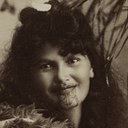0196 The Romanticized Māori – Māori Portraits on Late 19th- and Early 20th-Century Postcards and Photographs
Identifiers (Article)
Identifiers (Files)
Abstract
In New Zealand, daguerrotypes since the 1850s and later on wet-plate photography already had Māori portraiture as an important motif. The 1860s saw a dramatic rise in cartes de visite, and since the late nineteenth and early twentieth century, photos and postcards representing Māori men, women and children boomed. Mainly produced by Pākehā (European settler) photographers for a Pākehā audience, these portraits depicted Māori in a stereotypical way which also characterised photography on the Pacific Islands of the time: often propped with emblematic weapons or jewellery, men were staged as fierce warriors, women either as innocent belles or, like men, as very old, often with the allusion of a ‘dying race’. New Zealand tourism, especially in the Rotorua area with its thermal attractions, was thriving by the 1890s and brought along a souvenir production which already proved so large and lucrative that it was partly outsourced to companies in Germany. Cartes de visite and postcards were sent overseas in large numbers, evidence for 1909 shows a peak of nine million cards posted from New Zealand. Their impact as a form of popular media must have been immense, creating and perpetuating stereotyped images of Māori people in Aotearoa (the Māori name for New Zealand) and all over the Western world. However, the 1890s brought an increasing acceptance and appropriation of photographs by Māori people themselves. Especially in the tangi mourning ceremonies, photos of the deceased took a prominent part. Furthermore, the photos of important ancestors were given their place in the whare whakairo meeting houses.
Statistics


License

This work is licensed under a Creative Commons Attribution-NonCommercial-NoDerivatives 4.0 International License.



